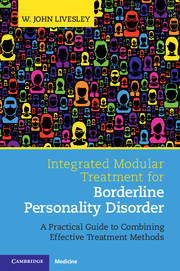 Integrated Modular Treatment for Borderline Personality Disorder
Integrated Modular Treatment for Borderline Personality Disorder Book contents
- Frontmatter
- Dedication
- Contents
- Preface
- Section 1 Introduction and Framework for Understanding Borderline Personality Disorder
- 1 Introduction
- 2 Understanding Normal and Disordered Personality
- 3 Understanding Borderline Personality Disorder
- 4 Origins and Development
- Section 2 Assessment and Treatment Planning
- Section 3 General Treatment Modules
- Section 4 Safety, Containment, and Engagement: The Initial Phase of Treatment
- Section 5 Improving Emotional Regulation and Modulation
- Section 6 Exploration and Change: Treating Interpersonal Problems
- Section 7 Constructing an Adaptive Sense of Self
- Section 8 Retrospect and Prospect
- References
- Index
3 - Understanding Borderline Personality Disorder
from Section 1 - Introduction and Framework for Understanding Borderline Personality Disorder
Published online by Cambridge University Press: 16 February 2017
- Frontmatter
- Dedication
- Contents
- Preface
- Section 1 Introduction and Framework for Understanding Borderline Personality Disorder
- 1 Introduction
- 2 Understanding Normal and Disordered Personality
- 3 Understanding Borderline Personality Disorder
- 4 Origins and Development
- Section 2 Assessment and Treatment Planning
- Section 3 General Treatment Modules
- Section 4 Safety, Containment, and Engagement: The Initial Phase of Treatment
- Section 5 Improving Emotional Regulation and Modulation
- Section 6 Exploration and Change: Treating Interpersonal Problems
- Section 7 Constructing an Adaptive Sense of Self
- Section 8 Retrospect and Prospect
- References
- Index
Summary
This chapter uses the idea of the personality system to develop an empirically based description of borderline personality disorder (BPD) organized around the idea introduced earlier that BPD has two main components: the emotional dependency constellation of traits and core self and interpersonal pathology.
Borderline Traits
The emotional dysregulation cluster of traits may be divided into three groups: emotional, interpersonal, and cognitive (see Table 3.1).
Emotional Traits
Underlying unstable emotions are two major traits: anxiousness and emotional lability. Other less-common traits, namely, pessimistic-anhedonia and generalized hypersensitivity, also contribute to the clinical picture in some patients.
Anxiousness
Although most theories emphasize emotional lability, patients with BPD are anxious and fearful. They tend to describe themselves as life-long worriers who see the world as threatening and malevolent and themselves as vulnerable and powerless, which makes them hyper-vigilant for indications of threat, especially loss, rejection, and abandonment. Consequently, emotional crises involve fear, panic-like anxiety, and rumination about painful experiences. The current framework for understanding BPD assumes that anxiousness is the cornerstone trait that influences the expression of other traits.
At this point, you may be wondering why I am emphasizing anxiousness when many patients show little overt anxiety and seem more angry than anxious. This is often the case. One reason is that the threat mechanism underlying anxiousness offers the option of responding with either fight or flight. Since anxiety increases feelings of vulnerability, many patients rapidly convert it into anger (fight), which is more tolerable. This occurred with one patient who rushed her young child who had suddenly become very ill to the local emergency room whereupon she immediately quarrelled with staff trying to treat the child. The intense anxiety about the child's safety was overwhelming and hence quickly expressed as anger. It was only later, when discussing the event in therapy, that she acknowledged her fear. This reaction is common in forensic settings where it is important not to appear weak lest this is exploited by others. However, despite the propensity to convert anxiety into rage, it is important to treat the underlying fearfulness by teaching stress management skills and restructuring appraisals of threatening situations.
- Type
- Chapter
- Information
- Integrated Modular Treatment for Borderline Personality DisorderA Practical Guide to Combining Effective Treatment Methods, pp. 29 - 38Publisher: Cambridge University PressPrint publication year: 2017
